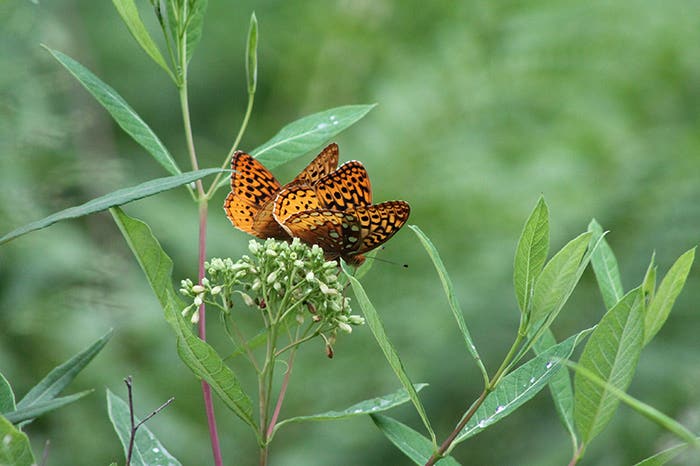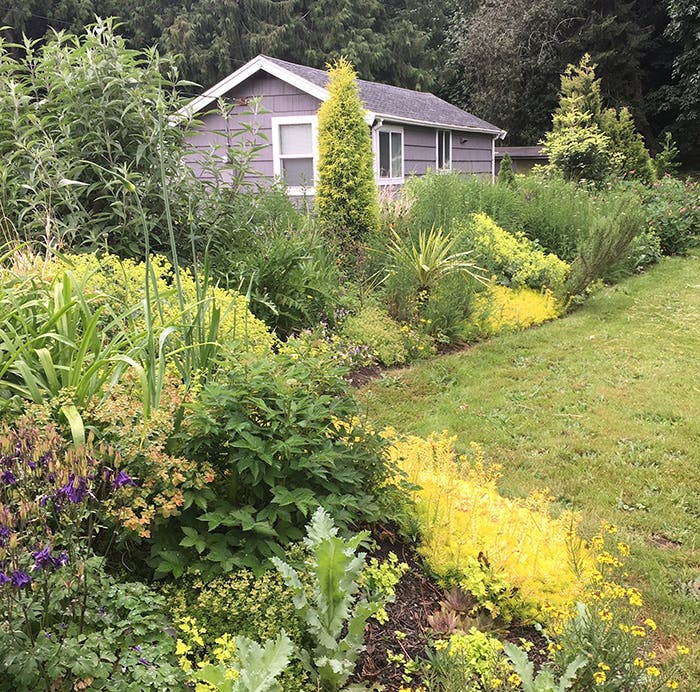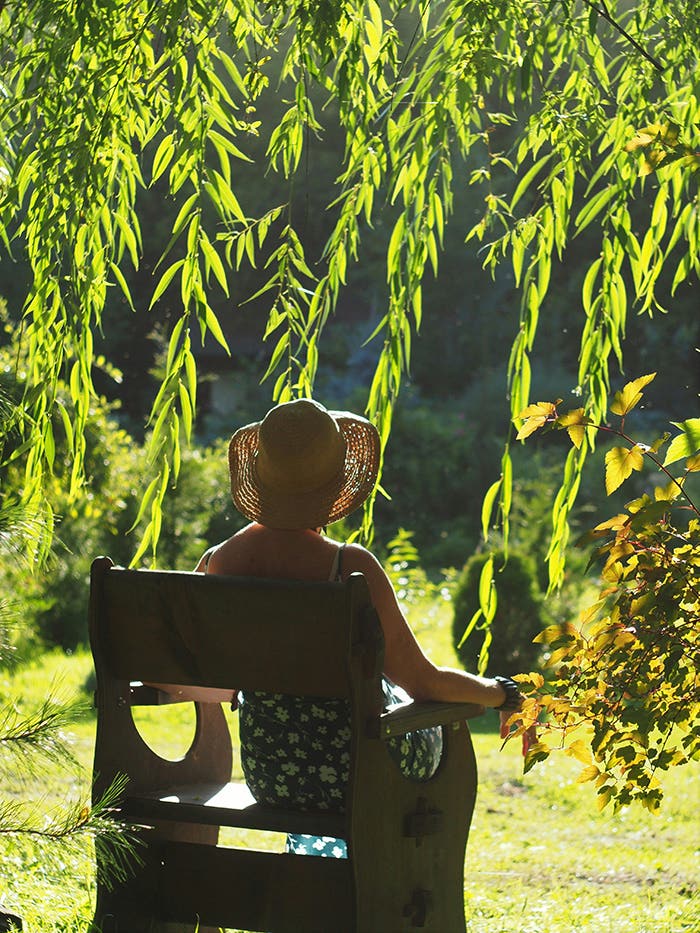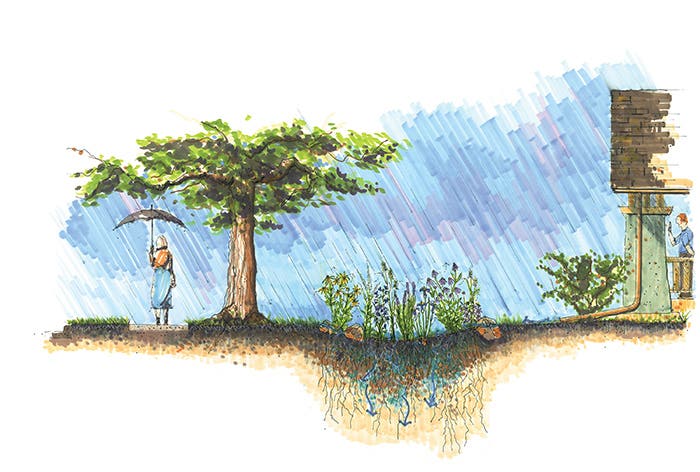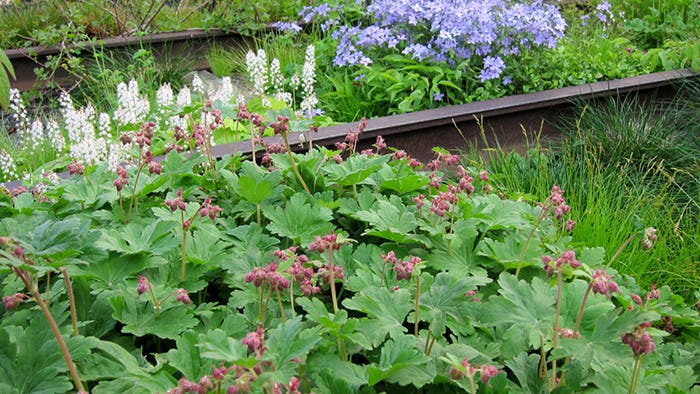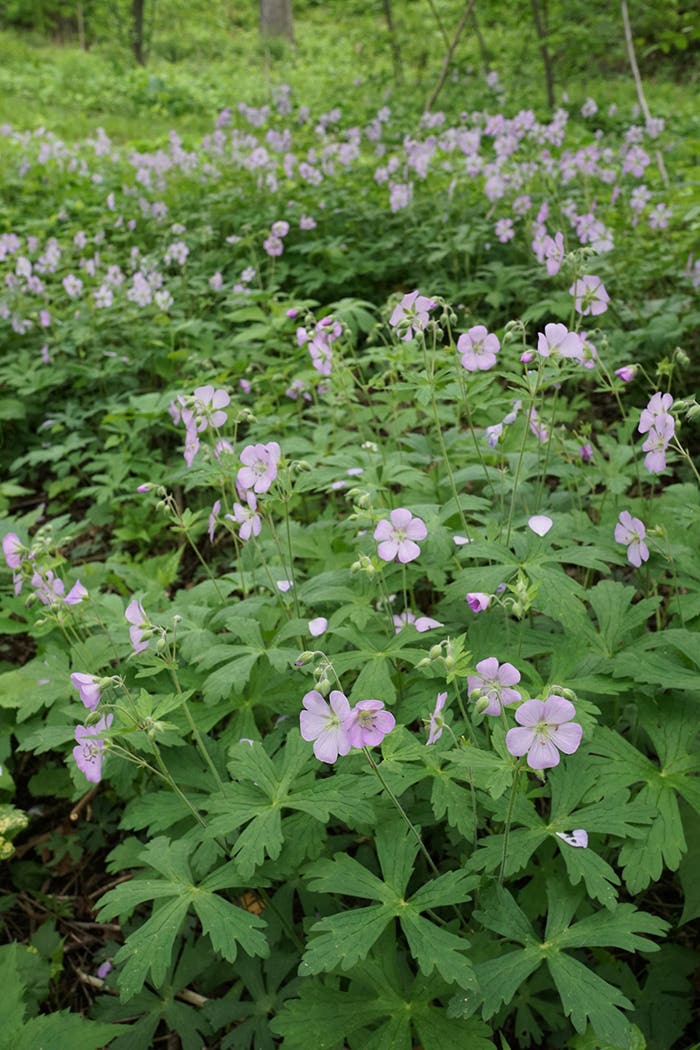The New German Style
PICTURE THIS: Orange ‘Fire King’ lilies standing between mounds of Euphorbia griffithii ‘Fireglow’ and scattered tufts of cream-plumed dropwort (Filipendula vulgaris ‘Multiplex’), all set in a low silver and violet-blue wash of catmint, stachys, and sages, and speared by the fat rockets of apricot foxtail lilies (Eremerus Ruiter hybrids). . . .
PICTURE THIS: Orange 'Fire King' lilies standing between mounds of Euphorbia griffithii 'Fireglow' and scattered tufts of cream-plumed dropwort (Filipendula vulgaris 'Multiplex'), all set in a low silver and violet-blue wash of catmint, stachys, and sages, and speared by the fat rockets of apricot foxtail lilies (Eremerus Ruiter hybrids). Now imagine 20 yards of it, the plants casually mingled and repeated like some fantasy meadow, over an entire sweep of sunlit, gravelly border.
This was my first taste of the "new" German planting style, in June 1993, in the trials garden at Weihenstephan, near Munich. I had been taken there by Brita von Schoenaich and Tim Rees, landscape architects in London, who have since brought over German designers to speak at Kew and, in the process, enlightened (and stunned) scores of British garden designers, park managers, and journalists. But back then, it was all new to me.
Weihenstephan was just the aperitif. Down the road in Munich's Westpark, we walked into an amphitheater of perennials spanning the best part of an acre, carved from a disused gravel pit, circled by trees and structured by rocks. Again, the core of it had been planted in rhythmic repetition over a stony soil surface, but this time in a gentle medley of colors: blue flax, violet salvias, yellow Phlomis russeliana, and, in partnership with the magenta balls of Allium rosenbachianum, a variety of bearded irises in lemon, purple, cream, and copper. Many plants had already flowered, but clearly there was much still to come. In fact, I was told, the garden was programmed to climax every three weeks! (I have since been back both in July and September, and can confirm it.)
Stone paths meandered about, one leading up through outcrops of gray rock into a short vegetation of yellow sedums, pink gypsophila, dwarf irises, and violet Campanula portenschlagiana, broken by eruptions of red and white valerian (Centranthus ruber). And fringing the trees at the edge of the garden, other paths skirted scattered bands of red, yellow, and orange daylilies, backed by violet Campanula lactiflora (an excellent combination for July).
But the most arresting feature was the grasses. They were everywhere, a hazy matrix against which the bolder flowering plants shone out. Not running grasses but clump-formers. This was open, gappy, border planting, not a close-knit sward. And, though there were outcrops of muscular miscanthus, the species tended to the short and wispy-mainly genera like Festuca, Pennisetum, Stipa, and Achnatherum. In June, their main contribution was arching foliage, but later would come a succession of inflorescences.
Not surprisingly, it was the look of the plantings that intrigued me initially. They were far removed from the English herbaceous or mixed border. There was no formal framework, no grading of heights from front to back, no segregated clumping, no unnaturally jazzy leaf colors or highly bred flowers, and no sense of the garden being a collector's cabinet of choice specimens. Instead, the effect was casual, mingled, and undulating, the majority of plants in each bed being much the same height as each other, as in a meadow. And this naturalistic quality was reinforced by the grasses.
But,meeting up with the Westpark scheme's designer, Rosemarie Weisse, I soon discovered that there was more to it all than simply a different, naturally graceful look. The planting also had rigorous ecological foundations. The plant selection was not random, but was based on the idea that each site in a garden approximates a natural habitat. By taking that as your cue, employing species found in that same habitat in the wild, and blending and managing them in a similar way, the notion is that you can build communities of garden plants so perfectly adapted to their setting that they also behave and interact as if they were in the wild. This means they largely look after themselves.
On this point, the proof of the pudding was in the Westpark. The plants were installed in 1983, but in all the intervening years have required no staking, hardly any lifting or dividing, very infrequent watering, and (except for two or three doses of hoof, horn, and bone, and one mineral supplement of crushed granite) no feeding. What does go on is regular hand weeding, deadheading (before dangerous seed loads are dropped), cutting back, and general troubleshooting; but no major upheavals. "Great expertise, but minimal input" is the guiding maxim. Yet not only does it look good all year, but even plants with a reputation for being labor intensive, like bearded irises, stay compact and full of flower.
How does this work? The secret lies partly in the soil. In the wild, the richer, more intricate plant communities tend to be found on ground relatively low in nutrients. So, these rock-garden and dry, stony meadow plantings at the Westpark are likewise kept hungry. The plants grow naturally short and tight. They don't luxuriate and fall over, as they do in response to manure and fertilizer, and they tend to live longer. The poor soil also suppresses weed activity.
The fertility of a site, as much as whether it is sunny or shady, moist or dry, always dictates the choice of plants in a German scheme. Many wildflowers do want a slightly richer medium --those from deep meadow, mountainside, and prairie soils, for example--and where these plants are grown in the garden, nitrogen levels may be gently topped up with annual application of compost; similarly, woodland perennials will be given leaf mold. But the sort of sky-high levels of fertility at which most of us have traditionally run our borders is contemplated only for highly bred hybrids, such as delphiniums and phlox, or where a deliberately larger-than-life effect is required. A naturalistic German planting scheme, by contrast, is much more likely to begin with the stripping off of topsoil, to reduce fertility, than with the addition of nutrients.
Then there is the way the plants are put together. The behavior of each species is taken into account. Invasive troublemakers are avoided, and partnerships are struck up between species compatible in growth habit, vigor, and flowering season. But this does not mean the plantings are fixed and static. On the contrary, gentle colonization and seeding is encouraged in many naturalistic schemes, and this activity is periodically monitored and edited. Plant communities can thus continually refresh themselves, as they would in nature.
This first visit to Munich rather ambushed me. Where had this ecological approach come from, and how many years had it taken to fine-tune it so spectacularly? Isabelle van Groeningen, an England-based designer who is writing a thesis on the subject, helped to put me in the picture. The roots seem to be back in the second half of the last century, when various writers began applying their deeply ingrained German love of landscape and nature-fueled by the floral wonders of the Alps --to gardens. William Robinson's The Wild Garden, published in Britain in 1870, was an inspiration for them, and a catalyst.
To Willy Lange, an influential author and lecturer, writing in 1907, a garden was "nature enriched"; he and others had begun listing plants, exotics as well as natives, according to their growing requirements and associations in the wild. And, significantly, there was no German equivalent to Gertrude Jekyll to derail the train of thought and champion an alternative, more painterly approach to planting.
The nurseryman Karl Foerster followed on, popularizing grasses for the first time, and then came the hero of the present day, Richard Hansen. As a research fellow and then professor, he began applying the scientific study of plant sociology to the trial gardens of Weihenstephan from 1947, developing the idea of planning borders as integrated, largely self-sustaining communities rather than as collections of individual plants.
In the process, he wrote, with Friedrich Stahl, the principal reference work on the German style, Die Stauden und ihre Lebensbereiche (1981) --published in Britain and the United States as Perennials and Their Garden Habitats. It makes fascinating, even essential reading, suggesting lists and combinations of plants for every conceivable niche in the garden, based not just on soil type, but also compatibility, longevity, and maintenance. (Alas, the English edition now seems to be out of print.)
There continues to be a terrific appetite for this sort of naturalistic planting among contemporary German designers, and the country's rolling program of garden festivals, staged as a means of revitalizing moribund urban parks, gives marvelous opportunities; Rosemarie Weisse's Westpark scheme began like this. Urs Walser, a pupil of Hansen's, is one of the most talented practitioners of the style, and his "meadow borders" at Hermannshof gardens in Weinheim are breathtaking-carefully color planned and each with a definite peak season.
The early-summer scheme features species like Salvia nemorosa, Knautia macedonica, Lychnis flos-jovis, and Achillea filipendulina among Atlas fescue grass (Festuca mairei). (Much of this is trimmed or weed-whacked after flowering --the herbaceous border that you mow!) Later come glamorous displays of rudbeckias, phlox, asters, and switch grasses (Panicum spp.); aesthetically, there is a preference for separating native plants from exotics, European from American. The shady areas boast some superb woodland community plantings, featuring Deschampsia grasses and Luzula woodrushes, ferns, brunnera, waldsteinia, and Solomon's seal.
Public parks are the principal showcase of this style of planting in Germany, there being no great tradition of private gardening as in Britain or America. And this great influx of colorful perennials (shrubs are employed very much as the harmonizing backdrop) certainly rings spectacular seasonal changes through the cities. This is clearly savored by visitors, in spite of the relatively bald and untidy winter aspect of stems and seed heads. As Rosemarie Weisse pointed out to me, this is, after all, part of the ebb and flow of nature. Indeed, there is such strong environmental benevolence in Germany that not only has a widespread ban on the use of chemicals by local councils been brought about, but the ban is actively monitored by the public, who are quite likely to protest at the sight of a weed-free rose bed, suspecting a chemical spray at work.
Naturalistic, low-maintenance gardening, prompted by soil type and situation, is not a new concept. Historic British examples range from heather-and-conifer gardens to exotic woodlands of magnolias, rhododendrons, maples, and hydrangeas, simply set among grass, leaf litter, and colonies of bulbs. What is new is the extension of the idea into the perennial border.
Across the world, different gardeners are pursuing the theme in different ways. On the East Coast of the United States, James van Sweden and Wolfgang Oehme (trained in the Netherlands and Germany) have pioneered a style that combines landscape --scale drifts of grasses and perennials-- sculpturally composed, but underpinned by ecology --with the crisp, clean lines of modern architecture. In the parched West and Southwest, I have seen superb compositions based on local wildflowers and the abstract art of cacti, succulents, and stone.
In Britain, Beth Chatto has long espoused an ecological approach, and her gravel, woodland, and waterside gardens near Colchester are really a plant collector's version of the German style. While in the Netherlands and elsewhere, nature has been the inspiration for a more painterly, less ecological planting style that carries the concept of the "meadow border" into the most ethereal realms imaginable. (More about that in a future issue.)
From Germany, though, we get the most systematic and scientific approach: an all-embracing school of naturalistic gardening, accompanied by a textbook (Perennials and Their Garden Habitats). The plants with which the German designers are experimenting may not all thrive in your garden or mine, but the principles can be translated anywhere. In Britain, the owners of several large private gardens are now devising communities of grasses and perennials suited to the local soil and climate. (Fund starved and stuck in their Victorian time warp, I'm afraid there is little chance that our public parks will follow suit.) In my next garden, I plan to join them-- meantime, monitoring their mistakes.
VISITING THE NEW GERMAN GARDENS: Located in southeast Germany, Munich's Westpark is a public park open all year, every day from dawn until dusk. Found at the end of the Westendstrasse; for more information, write Westpark, 80539-Munchen, Germany. Hermannshof is in the town center of Weinheim, which is near Heidelburg, in southern Germany. It is open from March to October, Tuesday to Sunday, 10 a.m. to 7 p.m. For more information, write the Schau- und Sichtungsgarten Hermannshof, 69469-Weinheim-an-der-Bergstrasse, Germany. Weihenstephan, the teaching and experimental garden of the University of Munich, lies in the town of Freising, just outside of Munich. It is open daily to the public, April to October from 8 a.m. to 6 p.m. (Saturday and Sunday the garden opens at 9 a.m.). For more information, call the Sichtungsgarten at 011-49-8161-713371. Online, point your browser to Europe for Visitors with Guide James R. Martin.
See page 22 of our September/October 2002 issue for more on German Style.


